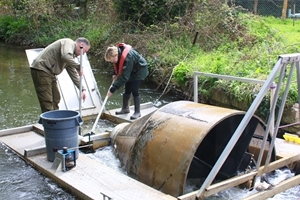By Rasmus Lauridsen, Fisheries Scientist
 This year’s smolt run has finally finished. After seven weeks of around-the-clock work, we are exhausted but pleased with the results. We estimated a total of 9,539 smolts passing our base at East Stoke in Dorset, which is slightly up on the five-year average (9,033), but down on the ten-year average (10,220).
This year’s smolt run has finally finished. After seven weeks of around-the-clock work, we are exhausted but pleased with the results. We estimated a total of 9,539 smolts passing our base at East Stoke in Dorset, which is slightly up on the five-year average (9,033), but down on the ten-year average (10,220).
The work starts in autumn, when the fisheries department and a team of volunteers head out to PIT tag around 10,000 salmon and 3,000 trout parr. Unfortunately, when we started the tagging last autumn, we had 80mm of rain in the first four days. This meant that the river was running high and the water was quite murky. There were days when we just weren’t able to get in the river at all, and when we were, it was harder to catch the parr. In total, we were only able to catch 8,424 salmon and 2,847 trout.
The number was so low that we didn’t think there were many fish at all. But it’s hard to tell – we never know what proportion of the total fish we have managed to tag until it gets to the smolt run.
Interestingly, if the little salmon and trout feel threatened, they like to hide rather than swim away. If there are lots of plants, they can take cover there and we can still catch them, but if there are fewer plants, they tend to swim around our feet, making them much harder to catch, and last year there was very low coverage of plants in the Frome.
When the parr have become smolts and head down river towards the sea, they are counted by our array of antennae across the river. As each smolt swims by it is detected several times. Statistical calculations tell us that our antennae as a whole are 92% efficient. In other words, if we detect 1,000 fish, we divide that number by 0.92 and know that the real number of fish passing was 1,087.
During the smolt run we also run a screw trap. We catch some PIT-tagged fish and some non-tagged fish, but all are measured so we can look at changes in smolt size and weight over time. From the number of tags we detect, the efficiency of the antennae and the proportion of tagged fish, we can calculate the total smolt number.
If you’re interested in being involved, we are always looking for volunteers. The trap runs 12-20 hours a day between March and mid-May depending on river conditions and is checked every 30 minutes when running. Volunteers are particularly useful to help us during the night shifts, allowing our full-time staff to continue their research. For more information, please contact Luke Scott.
Please support our Salmon Appeal
We're currently working on finding out why Atlantic salmon numbers have dropped by as much as 70% in some areas. Please give what you can afford so that our scientists can continue their vital work.